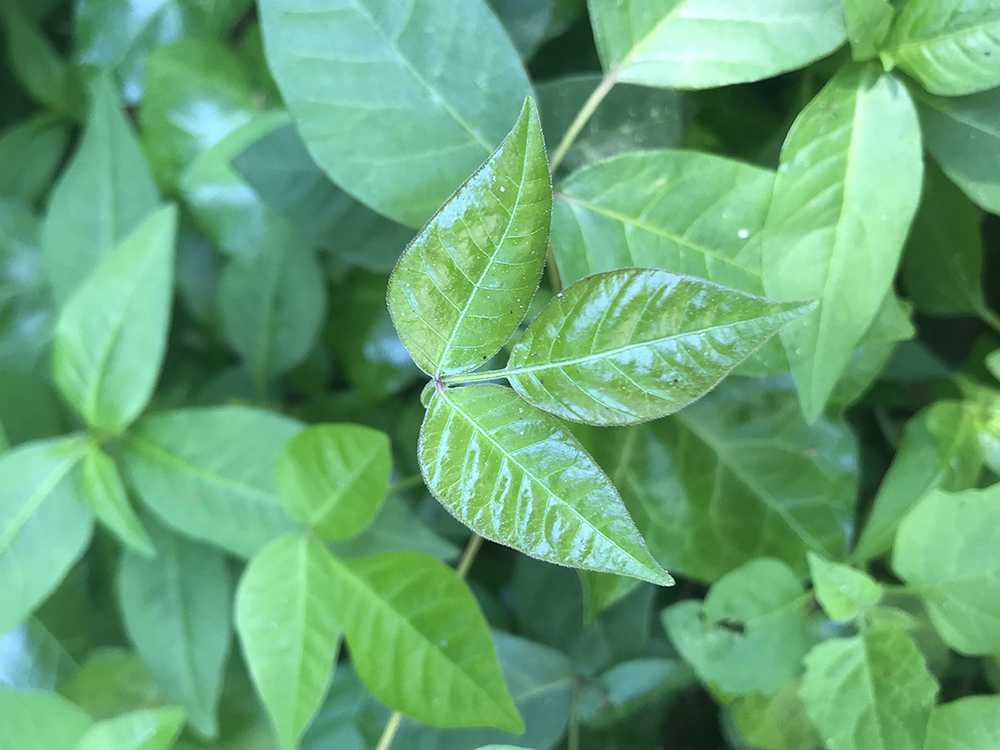Let It Grow
By Tammy Thornton
After a late start, warm weather has finally arrived and we couldn’t be more thrilled. Roses and peonies are enjoying basking in the sunny days, as gardeners are busy buying plants and soil. But a few bad players have entered the scene as well. While we are happily digging away, poison ivy lurks quietly beneath our feet, among the weeds, and over our heads. Knowing how to recognize this insidious plant can save you weeks of pain and frustration.
Poison ivy changes throughout the seasons, so learning each stage of the plant will help you avoid trouble. In early spring, we are eager to see everything sprouting and poking through the earth. But the tiny leaves and vines of poison ivy are growing as well, almost hidden at first. These small leaves often start out with a burgundy color. You may have heard the old adage warning of “leaves of three, let them be”? Even when the leaves of poison ivy are tiny, they will start forming on the vine in groups of three leaves. Keep in mind that the vine will spread along the ground, so you must avoid touching the vine as well. Later in the season, the leaves will quickly grow and turn green, then sometimes deepen to a dark, glossy green. Eventually, poison ivy will produce berries that birds and other animals can eat, thus spreading the plant further. In the fall, the leaves will start to turn the colors of yellow, red, and burgundy just like the leaves on trees and bushes.
All parts of the plant, including the leaves, stem, roots, and berries can cause you to have an allergic reaction. The itchy, bubbly rash can take a few days to emerge, sometimes showing up on different body parts later than the first signs of the rash. The allergic reaction occurs when our skin comes in contact with an oil called urushiol, contained in all parts of the plant. It’s the same allergen found in poison oak and poison sumac. This substance can get under our fingernails, and spread as we touch different parts of our body. The oil can remain on gardening tools and clothing for years. Though the rash itself isn’t contagious, your neighbor can get it from borrowing your shovel. If the oil remains on your shoes, you can become reinfected when you lace up again. Though your pet’s fur may protect them from getting the rash, Fluffy can carry the oil to you if they have brushed up against the leaves.

Your best defense against this irritating rash would be to learn what the plant looks like to avoid touching it. Poison ivy is often found growing alongside Virginia creeper (which has five leaves but can also cause an allergic reaction in some people) and English ivy. In addition to the garden, you can find poison ivy on a woodland hike or along the paths through the dunes leading to the beach. If you feel you might have been exposed to the plant, wash your hands and under your fingernails as soon as possible. Make sure you wash any clothing, tools, or pets that may be carrying the oil. You can purchase over-the-counter creams that you apply to your skin before you venture out that will provide a barrier between your skin and the urushiol oil. Since I’m highly allergic, I apply a small amount of Benadryl cream at the first sign of infection to slow the allergic reaction. But check with your doctor for medical advice.
If you find poison ivy in your garden, it’s like sin, you’ve got to deal with it or things will grow and get worse. Don’t touch it with your bare hands. Use thick rubber gardening gloves that you can rinse off or disposable gloves. Make sure you are removing the vine runners as well. I have also used a thick plastic bag to pull small pieces of poison ivy out, using the same bag to dispose of it, by turning it inside out. (Maybe your Pennsylvania visitors can bring you a plastic bag across state lines.) Whatever you do, don’t try burning poison ivy, since inhaling the smoke can cause serious consequences.
Learn to recognize poison ivy at all stages so you can avoid contact with this irritating plant. If you suspect you have been exposed, wash your hands, clothing and tools as soon as possible. Then you can go back to enjoying our beautiful beaches, woodlands, and gardens of South Jersey.
Tammy Thornton is a mom of four, a substitute teacher, and a Sunday school teacher. She is passionate about gardening and cooking, and loves the beach.






